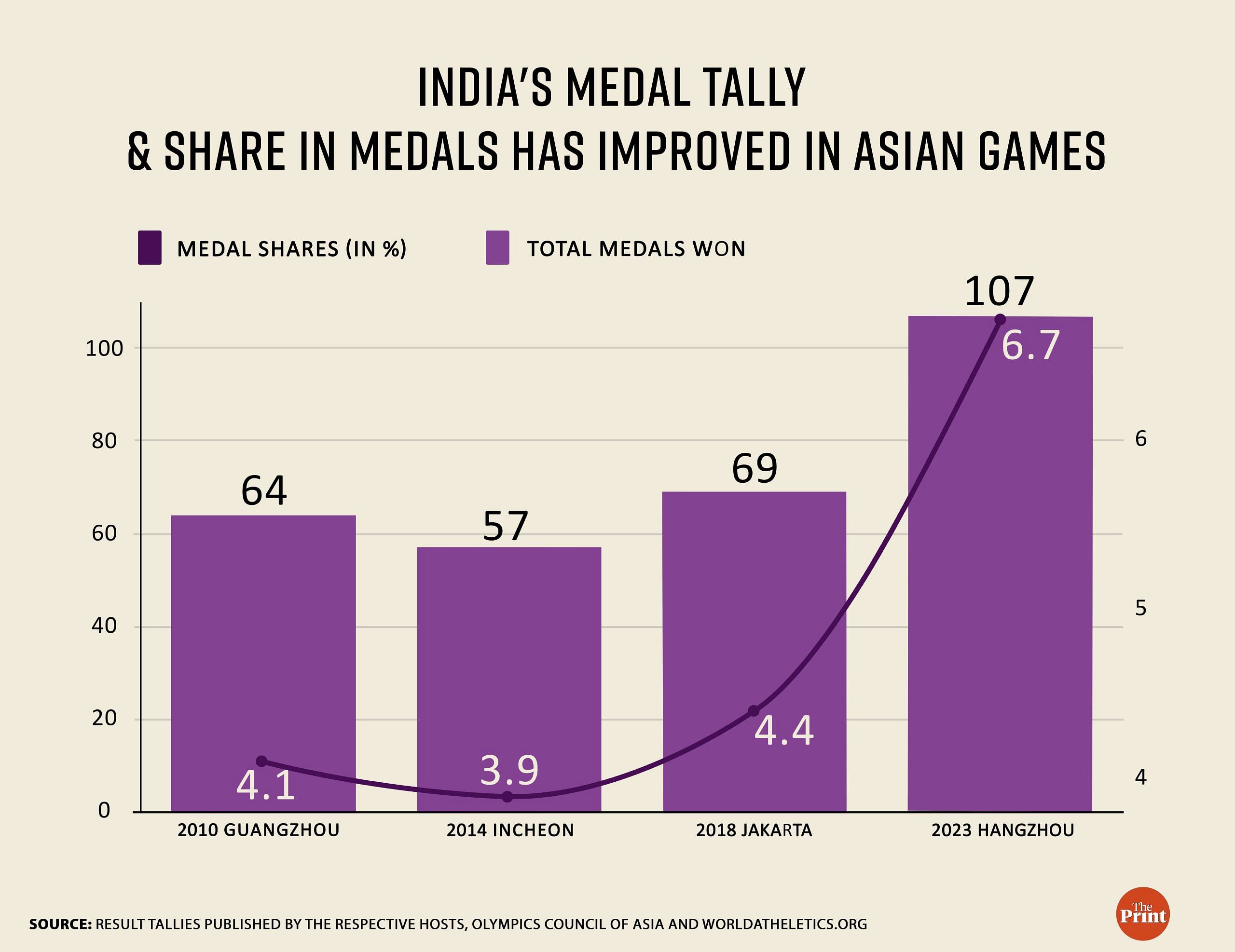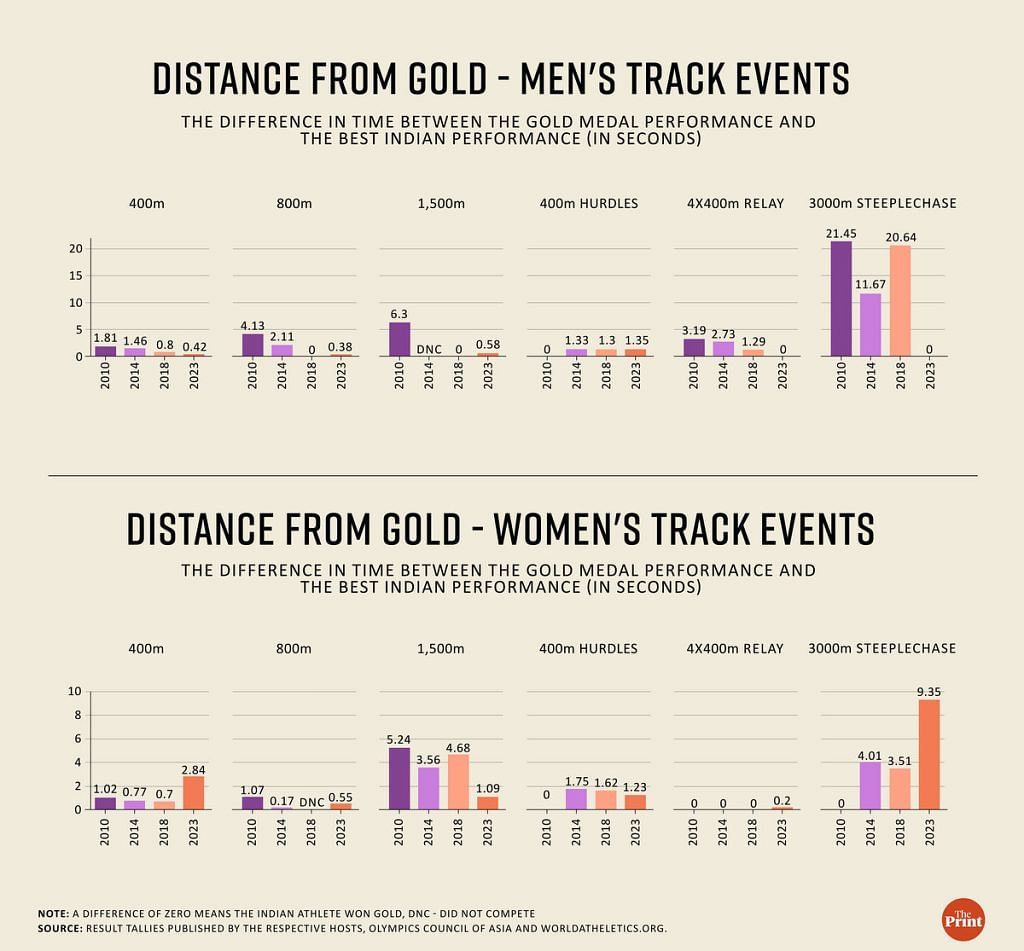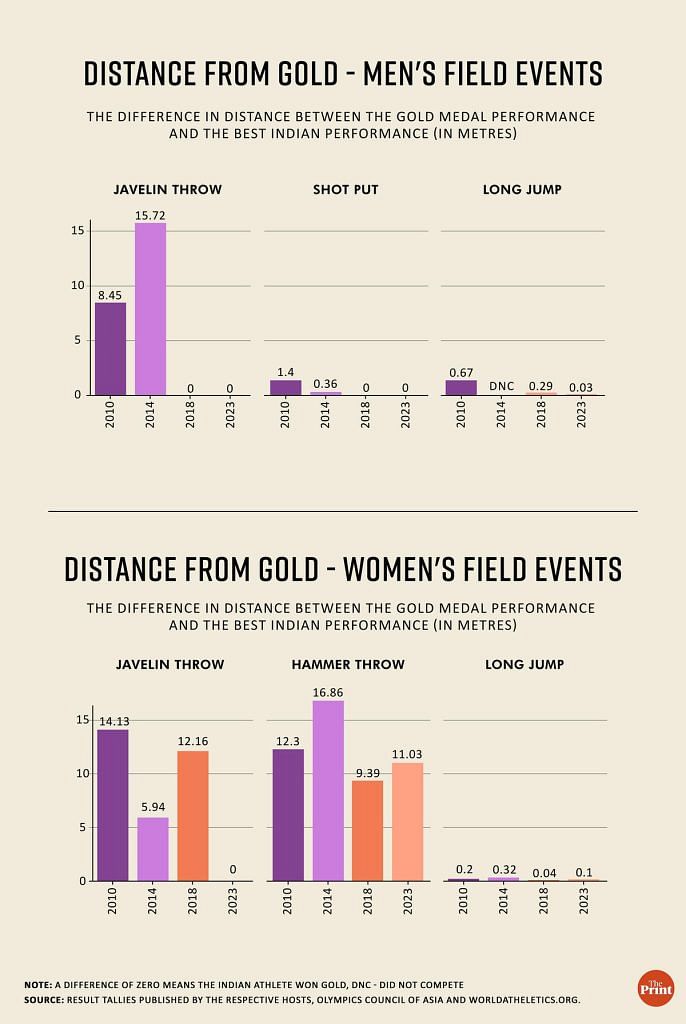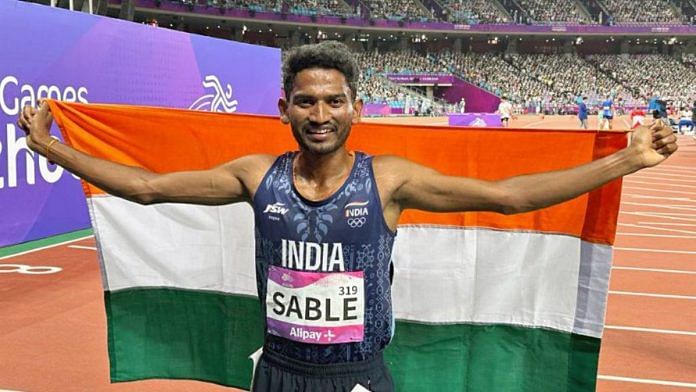Rome: India’s performance at the 2023 Asian Games in Hangzhou, China, was its best ever, with a record tally of 107 medals. The country’s medal share also improved from previous editions of the Asian Games. But while India’s overall performance was impressive, athletics stood out the most.
While India’s overall medal tally made up a 6.7 percent share of the total medals given out, its athletics medals comprised around 20 percent of the athletics medals on offer this year.
ThePrint analysed India’s performance in six track events and three field events—both men’s and women’s — over the last four Asian Games. Before that, in the 2006 Doha Asiad, the Indian men’s team couldn’t even qualify for many track and field events.
The data shows that since 2010, India’s athletes have been getting better and better each Asian Games. Overall, India’s male athletes have been getting faster and are catching up on the gold medal timings and distances.
Women athletes, however, have shown a more mixed performance—sometimes improving their times but not winning medals, sometimes performing less well than before but with a medal to show for it, and sometimes performing worse overall.
Also Read: ‘Country lost assured medal’ — Punia faces flak for Asian Games loss, INDIA bloc says ‘proud’ of him
Medals first
India’s 107 medals at this year’s Asian Games accounted for 6.7 percent of the total 1,593 medals up for grabs.
This marked a significant increase in share from the 4.4 percent achieved in the 2018 Asian Games in Jakarta, the 3.9 percent in Incheon 2014, and the 4.1 percent in Guangzhou 2010.
But where India really shone was athletics, where it won 29 medals or 20.1 percent out of the 144 medals on offer. These comprised 6 gold, 14 silver, and 9 bronze medals.
For perspective, almost 13 years ago in the Guangzhou Asian Games, Indians competing in athletics events earned just 12 medals in total, or 8.3 percent of the 144 medals on offer that year. India’s athletics medals increased to 13 (9.2 percent) in 2014 during the Incheon Asian Games in South Korea and then to 20 medals (13.8 percent) by the 2018 Jakarta Asian Games in Indonesia.

However, while India may have sprinted forward in the athletics chart this year, China reigned supreme with 39 medals, of which 19 were gold against India’s 6. Meanwhile, Bahrain, with a more modest total of 16 medals, managed to clinch an impressive 10 golds.
Faster sprints
India’s medal tally in track events was fuelled by a remarkable improvement in the performance of the country’s athletes.
ThePrint analysed India’s best performance at the Asian Games since 2010 for six key races—400 metres (m), 800m, 1500m, 4x400m relay, 400m hurdles, and 3,000m steeplechase.

Indian men excelled in all six of these events this year, with the most striking improvement observed in the 3,000m steeplechase—a demanding 3-km race involving vaulting over hurdles into shallow pools of water.
Avinash Sable secured a gold medal— becoming the first Indian to do so— with a timing of 8 minutes and 19.50 seconds. His performance surpassed that of Elam Singh’s in 2010 by 27.84 seconds. Singh had finished fourth that year with a timing of 8 minutes and 47.34 seconds.
Similarly, the men’s 4x400m relay team won its first Asiad gold medal in 10 years, finishing the race in 3 minutes and 1.58 seconds. This was 4.91 seconds faster than the 2010 team’s time of 3 minutes and 6.49 seconds, which had earned it fourth place.
Another way to look at it would be that in these two events, Indian athletes effectively closed their previous gaps of 21.45 seconds and 3.19 seconds behind the gold medallists in 2010.
Even some silver medallists came much closer to gold than their predecessors in 2010.
In the 1,500m race, Ajay Kumar Saroj secured a silver medal with a race time of 3 minutes and 38.94 seconds, coming within a mere 0.58 seconds of the gold medal. This marked a significant improvement from Sandeep Singh’s 6.3-second deficit in 2010.
In the 800m dash, India’s Mohammad Afsal finished the race in 1 minute 48.43 seconds for which he won a silver medal. This was 1.15 seconds faster than the time posted by India’s Sajeesh Joseph in 2010. Further, India missed the gold this time by just 0.38 seconds, narrowing the gap from 4.13 seconds in 2010.
The progress in shorter races also stands out, even in the absence of medals.
This year, Indian athlete Muhammad Ajmal Variyathodi, who finished fifth, managed to reduce the 400m dash timings by 0.96 seconds when compared to 2010. With a time of 45.97 seconds, he was just 0.42 seconds short of securing gold.
One way to look at this is that 0.42 seconds is an eternity in short races, and another is to compare this to 2010, when no Indian athlete even qualified for the final race.
But there were disappointments too. In the 400m hurdles, Yashas Palaksha finished in 49.39 seconds—0.57 seconds faster than in 2010. However, while India won gold that year, it did not win a medal in 2023. Instead, India was a substantial 1.32 seconds behind the gold-winning performance by Qatar.
Ups and downs for women
The performance of India’s women contingent for athletics has been a mixed bag.
For the 400m and 800m races, Indian women athletes’ performance lagged compared to their showing in 2010—by 0.42 seconds and 2.39 seconds, respectively. This means the Indian athletes were slower this year than in 2010.
In terms of gap from gold, the 800m dash saw a decrease from 1.07 seconds in 2010 to 0.42 seconds in 2023. The 400m race, on the other hand, saw an increase from 1.02 seconds in 2010 to 2.85 seconds in 2023.
In the 3000m steeplechase, Parul Chaudhary won a silver medal for India.
Her timing of 9 minutes and 27.63 seconds was 28.04 seconds faster than the 2010 finish time of 9 minutes 55.47 seconds. However, despite being slower, India’s Sudha Singh had bagged gold that year.
In a similar twist, the women’s 4x400m relay team improved their time by 1.17 seconds, missing the gold medal by just 0.2 seconds to Bahrain. The pinch was even greater since the Indian women’s relay team has won gold at the Asiad games consistently since 2006.
Another disappointment was the 400m hurdles, where India’s Ashwini Akkunji had won gold in 2010. This time, Vithya Ramraj won the bronze medal, with a distance to gold of 1.23 seconds.
Throwing their weight
The Indian squad showed remarkable improvement in three key field events — javelin throw, shot put, and long jump.
Star athlete Neeraj Chopra clinched gold with a jaw-dropping javelin throw of 88.88 metres. It marked a major improvement from India’s 2010 performance of 74.7 metres, which fell 8.45 metres short of gold that year.
Similarly, in shot put, Tajinderpal Singh Toor won the event with a throw of 20.36 metres. This was 1.19 metres better than India’s 2010 score of 19.17, which fell 1.4 metres shy of gold.

In long jump, India won its first Asian Games medal in 12 years. Murali Sreeshankar recorded a jump of 8.19 metres, winning him silver. His jump was 0.75 metres longer than the 2010 score of 7.44 metres. The gap for the gold medal also reduced from 0.67 metres to just 0.03 metres in this event.
Among the female track events, India demonstrated improvement in javelin throw and long jump.
Annu Rani won gold with a javelin throw of 62.92 metres, far surpassing the 2010 performance of 47.43 metres. The gap to gold in 2010 was 14.13 metres.
Ancy Sojan, who won a silver medal in long jump, leaped to a distance of 6.63 metres— almost 30 centimetres better than India’s 2010 performance of 6.33 metres. The gap for a gold medal also reduced from 0.2 to 01 metres.
Notably, although India’s Seema Punia won a bronze in the discus throw, the distance of 58.62 metres was 3.32 metres shorter than Krishna Poonia’s bronze-winning score for 2010. The gap for a gold medal increased from 4.24 metres in 2010 to 9.31 metres this time.
(Edited by Asavari Singh)
Also Read: Deogarh dreams of next hockey star. No turf, no shoes but ‘every house has a player & fan’



